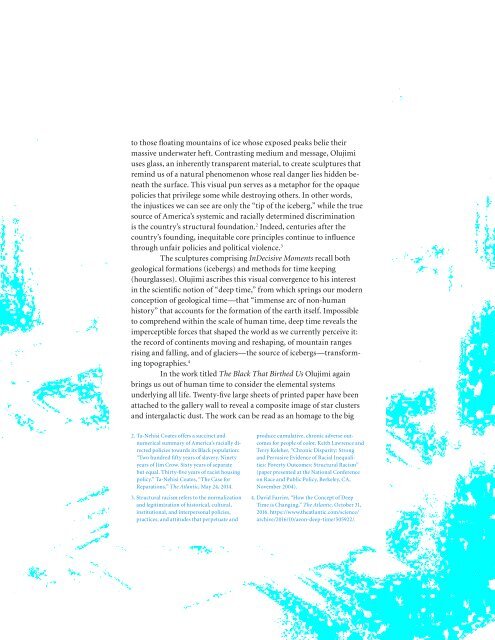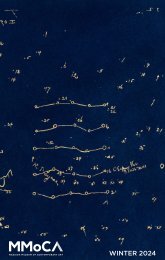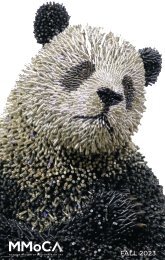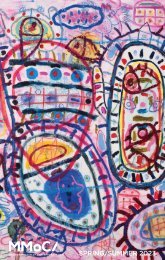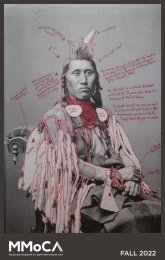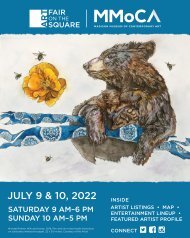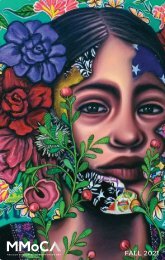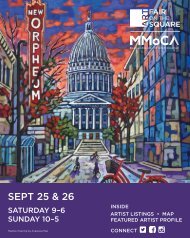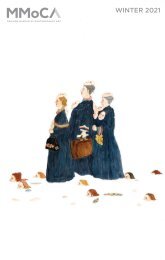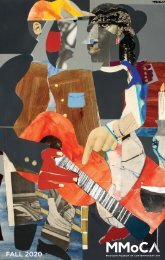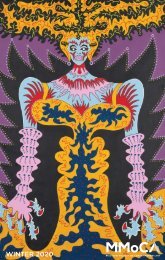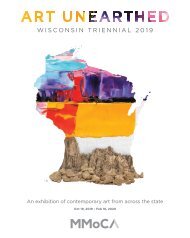Kambui Olujimi: Zulu Time exhibition catalog
This catalog is from the installation of this exhibition at MMoCA. It includes essays by Sampada Aranke, Leah Kolb, and Gregory Volk.
This catalog is from the installation of this exhibition at MMoCA. It includes essays by Sampada Aranke, Leah Kolb, and Gregory Volk.
Create successful ePaper yourself
Turn your PDF publications into a flip-book with our unique Google optimized e-Paper software.
to those floating mountains of ice whose exposed peaks belie their<br />
massive underwater heft. Contrasting medium and message, <strong>Olujimi</strong><br />
uses glass, an inherently transparent material, to create sculptures that<br />
remind us of a natural phenomenon whose real danger lies hidden beneath<br />
the surface. This visual pun serves as a metaphor for the opaque<br />
policies that privilege some while destroying others. In other words,<br />
the injustices we can see are only the “tip of the iceberg,” while the true<br />
source of America’s systemic and racially determined discrimination<br />
is the country’s structural foundation. 2 Indeed, centuries after the<br />
country’s founding, inequitable core principles continue to influence<br />
through unfair policies and political violence. 3<br />
The sculptures comprising InDecisive Moments recall both<br />
geological formations (icebergs) and methods for time keeping<br />
(hourglasses). <strong>Olujimi</strong> ascribes this visual convergence to his interest<br />
in the scientific notion of “deep time,” from which springs our modern<br />
conception of geological time—that “immense arc of non-human<br />
history” that accounts for the formation of the earth itself. Impossible<br />
to comprehend within the scale of human time, deep time reveals the<br />
imperceptible forces that shaped the world as we currently perceive it:<br />
the record of continents moving and reshaping, of mountain ranges<br />
rising and falling, and of glaciers—the source of icebergs—transforming<br />
topographies. 4<br />
In the work titled The Black That Birthed Us <strong>Olujimi</strong> again<br />
brings us out of human time to consider the elemental systems<br />
underlying all life. Twenty-five large sheets of printed paper have been<br />
attached to the gallery wall to reveal a composite image of star clusters<br />
and intergalactic dust. The work can be read as an homage to the big<br />
2. Ta-Nehisi Coates offers a succinct and<br />
numerical summary of America’s racially directed<br />
policies towards its Black population:<br />
“Two hundred fifty years of slavery. Ninety<br />
years of Jim Crow. Sixty years of separate<br />
but equal. Thirty-five years of racist housing<br />
policy.” Ta-Nehisi Coates, “The Case for<br />
Reparations,” The Atlantic, May 24, 2014.<br />
3. Structural racism refers to the normalization<br />
and legitimization of historical, cultural,<br />
institutional, and interpersonal policies,<br />
practices, and attitudes that perpetuate and<br />
produce cumulative, chronic adverse outcomes<br />
for people of color. Keith Lawrence and<br />
Terry Keleher, “Chronic Disparity: Strong<br />
and Pervasive Evidence of Racial Inequalities:<br />
Poverty Outcomes: Structural Racism”<br />
(paper presented at the National Conference<br />
on Race and Public Policy, Berkeley, CA,<br />
November 2004).<br />
4. David Farrier, “How the Concept of Deep<br />
<strong>Time</strong> is Changing,” The Atlantic, October 31,<br />
2016. https://www.theatlantic.com/science/<br />
archive/2016/10/aeon-deep-time/505922/.<br />
bang theory, which explains how the universe developed from a tiny,<br />
dense state into what it is today, including the most basic forces in<br />
nature, from electromagnetism to gravity. The science of the big bang<br />
and of deep time have enabled us to construct an encompassing view<br />
that places human history in the context of scientific historiography—<br />
a way to perceive what could not otherwise be seen.<br />
On the wall facing The Black That Birthed Us is a second<br />
composite image made from another set of 25 sheets of paper. Rather<br />
than conjuring associations to those forces outside of time that have<br />
impacted how we see the earth, Ville Radieuse, habite-à-machine (The<br />
Radiant City, the living machine) presents a view of the very human<br />
forces—situated within the perceivable chronology of historic time—<br />
that covertly direct the course of our lives.<br />
This installation pictures the implosion of St. Louis’s Pruitt-<br />
Igoe housing projects, the now-infamous public housing structures<br />
that stood as towering symbols of inner-city poverty before being<br />
demolished in the 1970s. But <strong>Olujimi</strong> does not simply replicate the<br />
archival image in large scale. Instead, he digitally alters it with visual<br />
echoes and stutters—blurring, multiplying, shrinking, cropping, and<br />
overlapping the image onto itself so that it bounces back and forth<br />
between clarity and obfuscation. He uses an image within an image<br />
within an image to represent the notion of a system within a system<br />
within a system. Thus, the formal attributes of this piece complement<br />
the artist’s conceptual point that inequalities, including housing<br />
inequalities, exist not on a single plane with one-point perspective,<br />
but within multiple contexts and facets that interact and interconnect,<br />
positioned on top of and within each other; some visible, some<br />
distorted, and some beyond sight.<br />
Familiar narratives constructed around the failures of<br />
Pruitt-Igoe blame modernist architecture, public assistance programs,<br />
or the predominantly Black residents themselves. 5 With Ville<br />
Radieuse, habite-à-machine, however, <strong>Olujimi</strong> offers a more complex<br />
reading. He suggests that focusing on the visible elements at the surface<br />
of the narrative—the architectural design of the project, public welfare<br />
programs, the inhabitants of the building—conveniently blinds us to<br />
the larger contextual forces at play: the economic decline of post-World<br />
War II urban St. Louis, and the city’s public policies and insidious<br />
18 19


